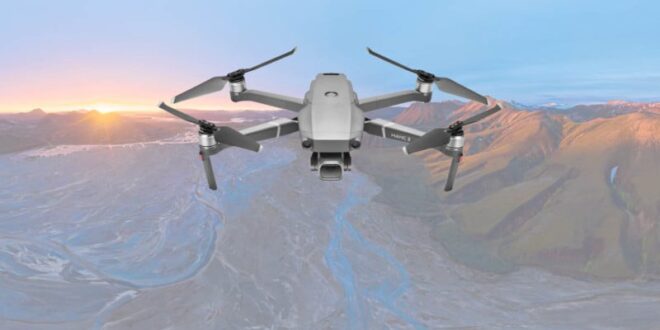Aerial photography can give viewers a unique perspective that differs from their everyday visual experience, and therefore can bring novelty to an image.
How is aerial photography achieved? Of course, it involves flying up into the sky. This can be divided into two categories: manned aerial photography and unmanned aerial photography, with manned aerial photography further divided into fixed-wing aircraft and helicopters. In this article, I will only discuss unmanned (drone) aerial photography, and only for static images, not video, as that is another topic of its own.
Why Photographers May Dismiss Drones
When it comes to drone photography, many diehard photographers tend to dismiss it. The reasons can be as follows:
1. Toys. How can these little “toys” produce serious photographic works? Serious works must come from serious equipment, and professional photographers must be well-equipped.
2. Vibration. The small drone keeps vibrating, and the images are blurry. Even when I take handheld landscape shots, I feel unprofessional, let alone using a shaking platform. It’s only suitable for play.
3. Image quality. How good can the image quality of a small camera be? I am not impressed with even the latest Sony 60mp full-frame camera, let alone this toy.
These may all be valid reasons, but critics of drone photography often forget a basic principle: the value that viewers assign to a photographic work is often unrelated to the technical quality or image resolution. Otherwise, that 3-inch photo of “Billy the Kid” would have been thrown in the trash long ago.
Expensive equipment doesn’t necessarily produce valuable works. The value of a work is determined by the author’s artistic vision and the uniqueness of the characters/scenery/event recorded by the camera. Image quality and technology are undoubtedly important elements of photography, but the commercialization of photography today has elevated their importance to an unparalleled level.
The Uniqueness of Drone Photography
So, what makes drone photography unique?
1. Height. No matter how we argue, without an aircraft, how can we lift our camera up to the sky to take photos? Even if we have a 100-meter-high tripod, I can guarantee that it shakes more than a drone. Our only option is to photograph on the ground. The world is three-dimensional, giving up one dimension (height) means giving up countless perspectives, especially those views that are not familiar in our daily life.
2. Portability. Using a helicopter with high-end photography equipment is considered professional, and this child’s play is considered inferior. This view also has some merit. But I’m sorry: unless the helicopter is mine and the pilot is my servant, I can’t just do whatever I want, and I would lose most of my shooting opportunities.
My first drone was a DJI Phantom 4 Pro, which I soon replaced with a DJI Mavic 2 Pro because of its portability. Today’s drones are the size of cameras and can coexist in the same backpack as my camera, so I can take them anywhere I go. I can adjust the camera’s height according to my composition needs at any time: whether to shoot on the ground with a tripod or in the sky, and even if I wake up in the middle of the night, I can still fly. The best camera is the one found where you want it to be.
I was shooting autumn colors in Colorado. The colors were beautiful, and the light was beautiful. I noticed that the ripples on the lake were special, so I took out my drone and shot from above. This convenience is irreplaceable by any other means. Even a helicopter cannot approach the surface of the lake without destroying its texture.
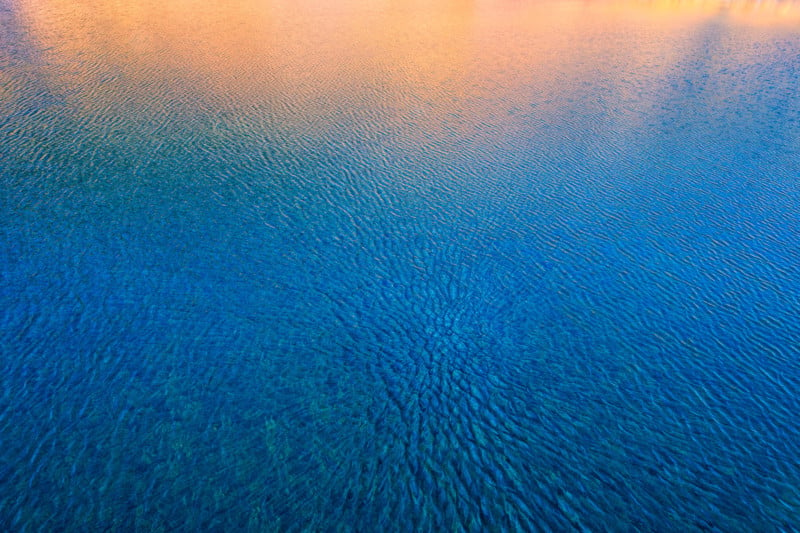
3. Cost. The cost of a helicopter that carries three passengers for a one-hour flight is over $3,000, or $1,000 per person. That’s enough to buy each passenger a relatively inexpensive drone. This hour includes travel time to and from the shooting location, so the actual shooting time is probably only half an hour or less. Unless I am a tycoon (or have a tycoon bankrolling me), I am destined to not be able to afford it. On my recent trip to Iceland alone, my drone flew for nearly forty hours. Using a helicopter would have been an unimaginable expense.
4. Height. Compared to helicopters, drones have altitude restrictions. The Federal Aviation Administration in the United States limits drone flight heights to 120 meters, which is not comparable to the heights that helicopters can reach. In certain shooting conditions, such as wildlife photography, a certain flight height is necessary to avoid disturbing the animals. However, being low doesn’t necessarily mean it’s a disadvantage. For example, drones can capture details on the ground at a height of a few meters. Can’t do that with a helicopter. Even if the pilot is highly skilled, the dust raised by the helicopter will immediately overwhelm the area.
I went to Iceland’s famous Diamond Beach. It was crowded with tourists and had been photographed countless times. I had no desire to take out my camera and could only take out my drone to look for a new perspective. After exhausting three batteries and flying for an hour and a half, I saw a heart-shaped wave. So, I had my drone waiting at a height of about ten meters until a perfect wave came again and then took the shot.
I can’t imagine any other means that would allow me to search freely, wait patiently, and take pictures without any danger of being swept away by the waves, regardless of cost.
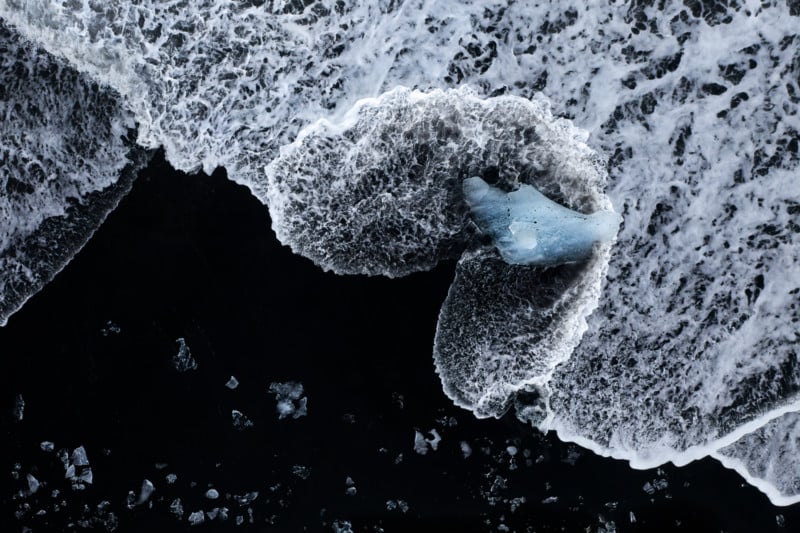
5. Range. Helicopters or fixed-wing aircraft can fly long distances, while drones can only fly several kilometers, which is often a limitation. But such comparisons are often misguided: a manned aircraft must take off from an airport, while drones always take off from my side. Drone photographers are already at the shooting location before they fly their drones.
6. No pilot. Often, the pilot is also the tour guide. The helicopter pilot will take you directly to the scenic spot, which is very efficient. The “pilot” of the drone is the photographer himself, who may have to find the scenic spot himself, which is more work. Is this a bad thing for creativity? Of course, there are also drone photographers who have tour guides take them to the scenic spots, which is another matter. Helicopters always have tour guides, but drones give you the freedom to break away from them. There is no creativity without freedom.
I walked along a remote riverbank. Not even a life animal nearby, let alone a tour guide. I launched my drone and observed the texture of the ground. Half an hour later, a stream dyed golden by minerals attracted me, so I flew and took pictures at a height of over ten meters, and stitched four images into the final work, “God’s Palette”.
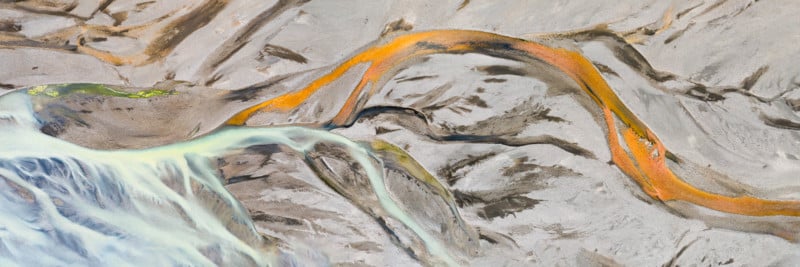
Image Quality in Drone Photography
Let’s talk about image quality, which is the most substantial argument against drone photography by opponents.
Speaking solely about the camera, the 20-megapixel camera equipped on a drone is superior to the image quality of high-end DSLR cameras from several generations ago. Does that mean the history of human photography only goes back a few years? How about the photographs hanging in museums? Should we give up photography today just because the best camera available today will be junk in ten years?
The latest drones have reached a critical point in terms of portability and image quality and can now meet the needs of serious photography.
The significant problem that drone photography needs to overcome is motion blur. A drone (and any aircraft) is a moving platform, and its vibration can cause motion blur. Motion blur is a technical problem that requires technical solutions. So, how do we overcome or at least reduce it?
1. Gimbal stabilization. Today’s drones used in photography are equipped with gimbal stabilization, which significantly reduces blurring caused by vibration. Most of today’s drones have a three-axis mechanical gimbal stabilization system. Although not the most cutting-edge stabilization technology, there is currently no better option for portable drones. Waiting for stabilization technology to solve everything would make us lose all reasons for aerial photography.
This is a photo I took in Iceland in 2018 using the DJI Phantom 4 Pro, flying at a height of dozens of meters with a wind speed of about 30 kilometers per hour.
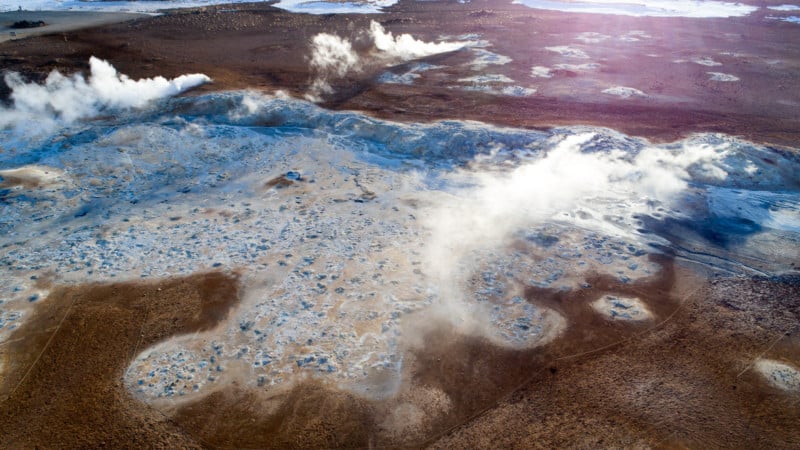
Note the ropes on the ground as railings, which are still clearly visible in the 1:1 crop.
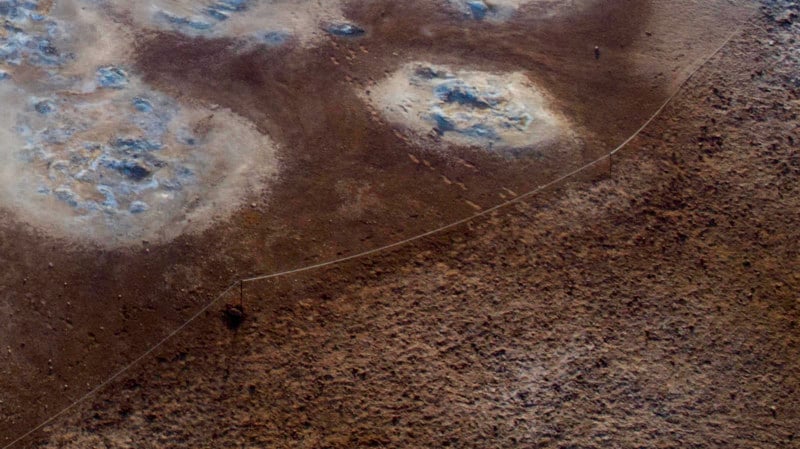
2. Increase shutter speed. I generally use a shutter speed faster than 1/100 second. Without image stabilization, a handheld camera’s shutter speed should be faster than 1/focal length. The theoretical handheld shutter speed limit for the 28mm camera on the DJI Mavic 2 Pro is 1/28 second. With a speed of 1/100 second and the help of the stabilizing gimbal, the impact of jitter is relatively small.
3. Try to avoid flying in strong winds. My motto is that if a person can’t stand still, a drone will not be stable, and it may be blown away by the wind and never return. We should know when to give up.
4. Post-processing. Sharpening in post-processing can certainly increase sharpness, but over-sharpening can make the image look harsh and unnatural. Today’s AI technology takes a completely different approach. It “guesses” and fills in lost details based on the texture of the image and the knowledge it has learned, rather than sharpening indiscriminately. For a high-definition image taken with a camera on a tripod, its effect is not significant. But for drone images with motion blur, its effect can be huge. In the past few years, I have used it extensively to process aerial photographs.
For the same image, in a 1:1 crop, the sharpness of the rope is greatly improved by the sharpening processing of the AI sharpening software, and the stones on the ground are also clearly visible. Even if a DSLR camera is mounted on a sturdy tripod with a 24mm wide-angle lens and used to photograph a rope tens of meters away in 30 km/h winds, how much sharper can it be?
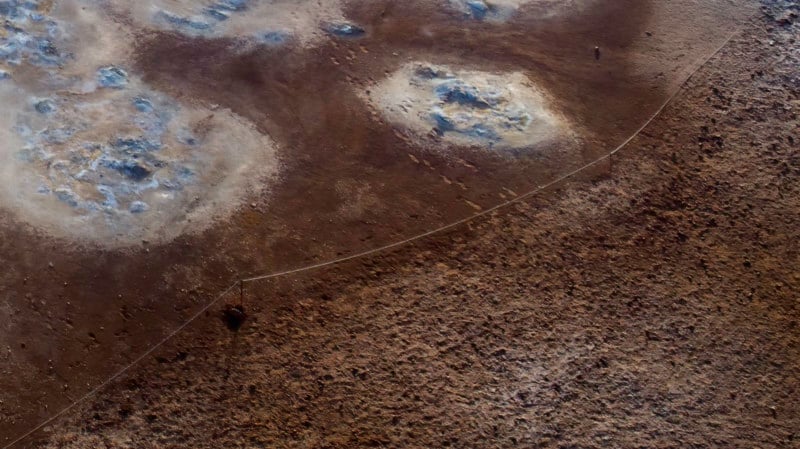
Instead of worrying about resolution, it’s better to open our arms and embrace this new era. Our era will never be perfect because by the time it reaches “perfection,” it would be another imperfect new era, and we would have become irrelevant to our then-current era in the future. Imperfect drones have undoubtedly become one of the serious tools for photographers.
Things to Pay Attention To
So, what should we pay attention to in drone photography?
1. Drone photography is also photography, not a toy. The only difference between it and other forms of landscape photography is the height of the “tripod”. Without unique light, moments, and composition, photos taken from high up can also be junk. Often, photographers would carefully set up their cameras on tripods when light is good but will fly their drones when there is nothing to do. How can mediocre light produce exceptional work?
Overcast skies are common in Iceland. Waiting for sunrise or sunset to capture color in clouds is often in vain. This evening, dark clouds hung over the sky, so it was best to go to bed early. Perhaps it was a blessing from above, but in the middle of the night, I woke up to see a hint of red color on the horizon. I quickly went out to take a picture, but the composition on the ground was not satisfactory.
In order not to disturb others, I flew my drone far away from the campsite and captured a breathtaking view of the entire valley. The battery died after only half an hour, and the light disappeared. There were less than 45 minutes of good lighting. The convenience of the drone allowed me to capture such a magnificent scene.
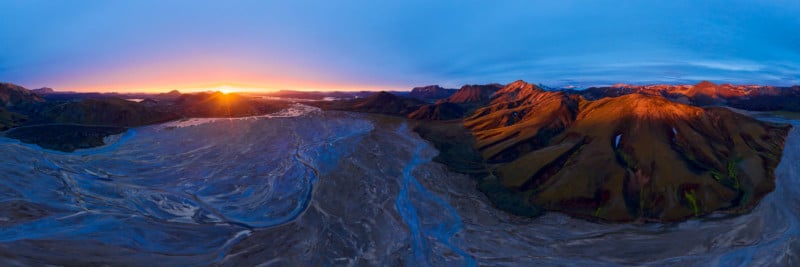
Under backlight conditions, I had to underexpose by one stop to avoid overexposure and brighten up the shadows by two to three stops in post-processing. I used 24 drone images to stitch together a 200mp panoramic image.
Some may grumble that 200 million pixels are useless if it is blurry. Let’s look at a 1:1 crop of a small piece a few kilometers away in the middle of the picture. How many DSLR cameras on tripods with wide-angle lenses can capture distant objects a few kilometers away with greater clarity?
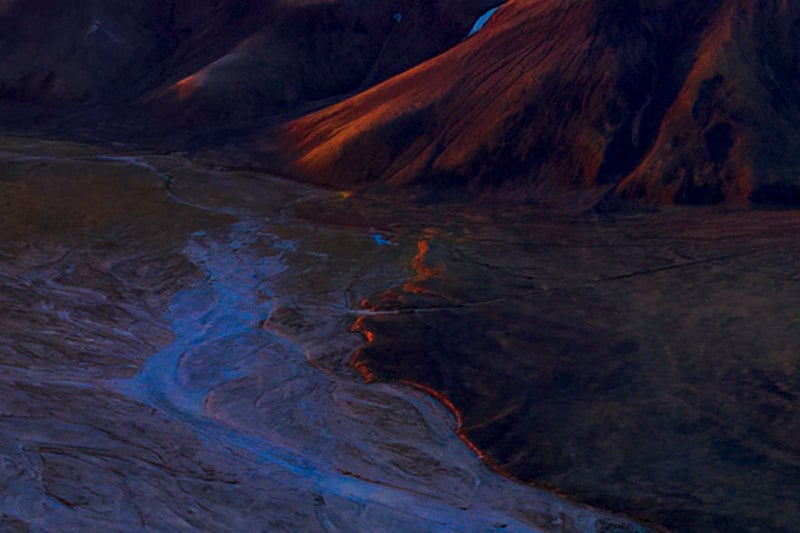
2. Drones are not meant to be used as a shortcut to hard work, and they cannot replace the photographer’s on-location experience of the scene and the creative inspiration that comes from it. Simply flying over a scene may allow you to capture it, but it won’t necessarily result in a great shot.
3. High viewing angles may not always be the best choice for a specific scene. Aerial photography (including helicopters and drones) may be the worst composition choice for some scenes. For example, when trying to capture a towering mountain, the lack of foreground elements may result in a flat image without depth. It might be better to stay on the ground and use a different perspective to capture the scene. Conversely, for a flat and featureless landscape, looking at it from above with a drone can reveal many textures and patterns not ordinarily seen by human eyes. Remember, a camera is just a tool, not the only tool.
Even an ordinary water flow can reveal something unique when viewed from a different angle.
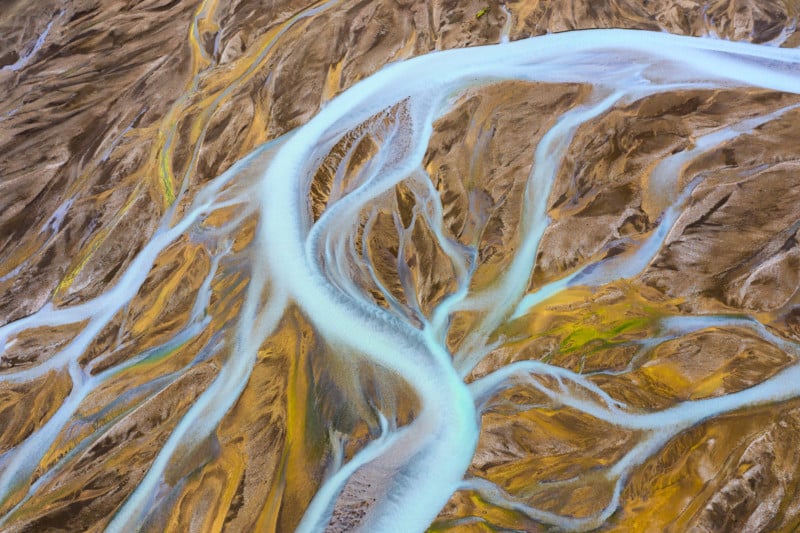
4. Finally, it is important to emphasize that there are different laws regarding drone flights in different countries, and it is important to understand height restrictions and no-fly zones. It is not worth getting in trouble. It is best to avoid flying over people’s heads in crowded areas and avoid causing resentment towards photographers.
About the author: John Fan, Ph.D., is a medical physicist in radiation oncology. Besides his outstanding professional career, John is also a world-renowned photographer. He is the winner of many prestigious photography awards. His work has been published extensively in international magazines, books, and gallery exhibitions, including solo exhibits in China. His photography books “Rational Inspiration” and “Talks about Photography” were published in 2017 and 2019 respectively. His photography blog enjoys over 1 million readers and 44,000 subscribers. He is also a curator of the online photo gallery 1X.com and its China ambassador, co-founder of the acclaimed 4Aperture fine art photography group, and founder of Raying Photography Group. All his photography works are presented on his personal website.
 Unmanned Aerial Vehicle The latest drone news
Unmanned Aerial Vehicle The latest drone news
